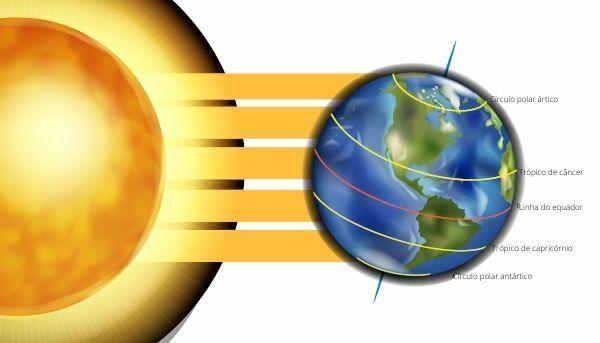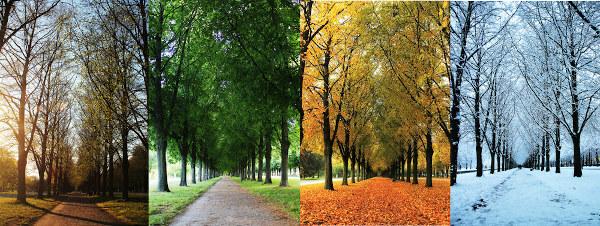The emergence of seasons is a consequence of the constant movement in which the Earth is found. These stations help us to perceive the nature cycles, such as heating, cooling, loss of leaves or flowering of flowers. In some parts of the planet, these cycles are well perceived in landscapes, but in others, this perception is significantly reduced.
The seasons of the year are: spring, summer, autumn and winter. Each of them has its own characteristics.
Read too: Earth's atmosphere - layer of air that surrounds the Earth and is composed of different gases
What causes the seasons?
Due to the Earth's tilt angle, 23rd 27’, and translation movement, which occurs around the shello, we have the changing seasons. This is because, during the translation movement, which lasts a year, the incidence of sunlight is different in each region, due to the tilt of the planet.

Because of that, there is a greater sunstroke in the Southern Hemisphere for a few months of the year, and then the situation is reversed, with a greater incidence of sunlight in the Northern Hemisphere. So when it's summer in the south, it's winter in the north, and vice versa. The same happens with autumn and spring,
that alternate between the hemispheres: when it's autumn in the south, it's spring in the north.Dates of the seasons of the year
Northern Hemisphere Seasonal Dates
Thanks to astronomical observations, scientists were able to trace a four seasons start and end calendar in both hemispheres. This definition of dates happens in an official way, but not in a practical way, because some countries do not have well-defined seasons, like Brazil.
In the Northern Hemisphere, the start and end dates of the seasons of the year are as follows:
Winter: December 22 to March 20;
Spring: March 20th to June 21st;
Summer: June 21st to September 23rd;
Autumn: 22/23 September to 22 December.

Dates of the seasons of the year in the Southern Hemisphere
In the Southern Hemisphere, the dates are inverted because of the tilt of the Earth's axis, which differentiates insolation in regions of the planet.
The start and end dates of the seasons are as follows:
- Summer: December 22 to March 20;
- Autumn: March 20th to June 21st;
- Winter: June 21st to September 23rd;
- Spring: 22/23 September to 22 December.
See too: Causes and consequences of climate change in Brazil and worldwide
Characteristics of the seasons
Due to the tilt of the Earth's axis, the seasons are well defined in areas located in the temperate zones and subtropical zones, following a pattern of characteristics throughout the year.
On the other hand, in polar areas and those located at high latitudes, close to the Equator, there is no such variation of characteristics between seasons, as it is either too cold (poles) or too hot (regions close to the Ecuador).
Seasons start and end according to the dates mentioned above, but its characteristics are not constant, as the weather varies throughout the year. Thus, it is quite common to have hot and cold waves in times other than summer or winter.
As characteristics of the seasons, we can mention the following:
- Summer: it is the hottest season of the year, having the longest days and the shortest nights. It has a large amount of rain due to the high evaporation of water accumulated in the soil.
- Autumn: in general, several leaves from the trees fall, and many flowers turn into fruits, serving as food for the region's fauna. It is known for being the fruit season.
- Winter: it is the coldest season of the year. Nights are longer and days are shorter, with some animals hibernating.
- Spring: is known as the flower season. In this season, temperatures are milder.
These characteristics transform society's behavior, because, at one time, we used more coats; in another, we go to the beach more often; our food is altered to withstand certain weather conditions, among other changes. That's why it's so important for us to know the characteristics of the seasons.
Seasons of the year in Brazil
In Brazil, as it is a country located among the TCancer and Capricorn and being situated very close to the Equator Line, the seasons have slightly different characteristics, varying by region and climate type. The most predominant seasons are winter and summer, but we can feel the effects of autumn and spring in some regions.
In most regions, the spring marks the beginning of the rainy season, as is the case in the Midwest, Southeast and South. In the Northeast and North regions, this season marks the beginning of the period of water scarcity.
O Winter, the coldest season, is very noticeable in the southern region, reaching negative temperatures. This is because this region is below the Tropic of Cancer, in a temperate zone, with well-defined seasons. In the North region, rains occur, despite the low temperature. This is because the northern region is close to the equator, there is a lot of vegetation and a large number of rivers. In the Midwest and Southeast regions, this is the period when there is the lowest rainfall (rainfall) and low humidity, which favors the emergence of respiratory diseases.
Already O summer It's very similar throughout Brazil, with high temperatures and heavy rains, especially in the Midwest and Southeast. In this season, days are longer than nights. There are also quick rains, the famous summer rains, but there can also be big storms and thunderstorms.
O autumn, typical season ofreduction in air temperature and humidity, is little noticed in Brazil, with the exception of the Midwest, South and Southeast. In regions with many mountains, temperatures fall gradually, giving signs that winter is approaching. Also, there are reduction in rainfall.
Also access:Brazilian biomes - what are they and characteristics
solved exercises
Question 1 - (UFMG) All alternatives have mechanisms responsible for seasonal changes throughout the year, EXCEPT:
a) The tilt of the Earth's rotation axis determines that, every six months, one hemisphere is more exposed to the sun than the other.
b) Seasons are determined by the greater or lesser proximity of the Earth to the Sun, a distance that, by varying throughout the year, alters the amount of solar energy applied to the planet.
c) The Sun, when reaching its point of greatest displacement to the North – the maximum boreal declination – determines, in the Southern Hemisphere, shorter days and longer nights.
d) The equinoxes occur, respectively, when the Northern and Southern hemispheres are equally illuminated, marking the astronomical beginning of spring and autumn.
e) Solstices occur, respectively, when illumination is maximum in one hemisphere and minimum in the other, marking the astronomical beginning of summer and winter.
Resolution
Alternative b. The seasons of the year are determined by the translation and inclination of the Earth in relation to its own axis.
Question 2 - About the seasons, we can correctly state that:
a) are originated thanks to the Earth's rotational movement.
b) are well defined in all locations on the planet.
c) have a direct relationship with the presence of time zones.
d) they exist thanks to the planet's translation movement, being well defined in temperate zones.
e) happen identically in both hemispheres.
Resolution
Alternative d. In temperate zones, seasons are well defined. Furthermore, the stations exist thanks to the translation movement.


